How Do Population Changes and Land Use Policies Affect the Relationship between the Urban Economy and Public Services?
Abstract
:1. Introduction
2. Theoretical Framework
3. Research Methods and Data
3.1. Selection of Indicators
3.2. Research Methods
3.2.1. Degree of Coupling Coordination
3.2.2. Gray Relational Degree
3.2.3. Spatial Autocorrelation
3.3. Data Sources
4. Results Analysis
4.1. Shrinking City Distribution
4.2. PUL Rate
4.3. Coupling and Coordination Degree of the Economy and Public Services
4.4. Gray Correlation Strength
4.4.1. Gray Correlation between the Population Change Rate and Degree of Coupling Coordination between Economy and Public Services
4.4.2. Gray Correlation between the PUL Rate and the Coupling Coordination Degree of Economy–Public Services
4.5. Spatial Autocorrelation
4.5.1. Global Moran’s I
4.5.2. Anselin Local Moran’s I
4.5.3. Hot Spot Analysis
5. Discussion
5.1. The Influence Mechanism of Population and Land Use Policy on Urban Economy–Public Services
5.2. Policy Suggestions
5.3. Limitations
6. Conclusions
Author Contributions
Funding
Data Availability Statement
Conflicts of Interest
References
- Herrmann, D.L.; Shuster, W.D.; Mayer, A.L.; Garmestani, A.S. Sustainability for Shrinking Cities. Sustainability 2016, 8, 911. [Google Scholar] [CrossRef]
- Zheng, X.; Luo, Y.; Su, B.; He, P.; Guo, C.; Tian, Y.; Han, S.; Chen, C.; Wang, Y.; Liu, J.; et al. Developmental Gerontology and Active Population Aging in China. China CDC Wkly. 2023, 5, 184–187. [Google Scholar] [CrossRef]
- Yan, D.; Li, P. Can Regional Integration Reduce Urban Carbon Emission? An Empirical Study Based on the Yangtze River Delta, China. Int. J. Environ. Res. Public Health 2023, 20, 1395. [Google Scholar] [CrossRef]
- Zhang, Y.J.; Fu, Y.; Kong, X.S.; Zhang, F. Prefecture-level city shrinkage on the regional dimension in China: Spatiotemporal change and internal relations. Sustain. Cities Soc. 2019, 47, 101490. [Google Scholar] [CrossRef]
- Oswalt, P.; Beyer, E.; Hagemann, A.; Rieniets, T. Atlas of Shrinking Cities; Hatje Cantz Publishers: Stuttgart, Germany, 2006. [Google Scholar]
- Turok, I.; Mykhnenko, V. The trajectories of European cities, 1960–2005. Cities 2007, 24, 165–182. [Google Scholar] [CrossRef]
- Wiechmann, T. Errors Expected Aligning Urban Strategy with Demographic Uncertainty in Shrinking Cities. Int. Plan. Stud. 2008, 13, 431–446. [Google Scholar] [CrossRef]
- Alves, D.; Barreira, A.P.; Guimarães, M.H.; Panagopoulos, T. Historical trajectories of currently shrinking Portuguese cities: A typology of urban shrinkage. Cities 2016, 52, 20–29. [Google Scholar] [CrossRef]
- Levitt, T. EXPLOIT the Product Life Cycle. Harv. Bus. Rev. 1965, 43, 81–94. [Google Scholar]
- Wang, Y.P.; Fukuda, H. Sustainable Urban Regeneration for Shrinking Cities: A Case from Japan. Sustainability 2019, 11, 1505. [Google Scholar] [CrossRef]
- Ojasalo, J.; Kauppinen, S. Public Value in Public Service Ecosystems. J. Nonprofit Public Sect. Mark. 2024, 36, 179–207. [Google Scholar] [CrossRef]
- Guan, D.; He, X.; Hu, X. Quantitative identification and evolution trend simulation of shrinking cities at the county scale, China. Sustain. Cities Soc. 2021, 65, 102611. [Google Scholar] [CrossRef]
- Khmara, Y. On the road to urban degrowth economics? Learning from the experience of C40 cities, doughnut cities, Transition Towns, and shrinking cities. Cities 2023, 136, 104259. [Google Scholar] [CrossRef]
- Nedden, M.Z. Leipzig—Eine wachsende Stadt in einem schrumpfenden Umland. Disp. Plan. Rev. 2010, 46, 95–99. [Google Scholar] [CrossRef]
- Wang, X.; Li, Z.; Feng, Z. Classification of Shrinking Cities in China Based on Self-Organizing Feature Map. Land 2022, 11, 1525. [Google Scholar] [CrossRef]
- Liang, L.; Chen, M.; Lu, D. Revisiting the Relationship Between Urbanization and Economic Development in China Since the Reform and Opening-up. Chin. Geogr. Sci. 2022, 32, 1–15. [Google Scholar] [CrossRef]
- Chen, J.; Fleisher, B.M. Regional Income Inequality and Economic Growth in China. J. Comp. Econ. 1996, 22, 141–164. [Google Scholar] [CrossRef]
- Guo, S.; Ma, H. Can the Spatial Function Division of Urbanization Promote Regional Coordinated Development? Evidence from the Yangtze River Economic Belt in China. Sustainability 2022, 14, 7115. [Google Scholar] [CrossRef]
- Qiao, B.Y.; Martinez-Vazquez, J.; Xu, Y.S. The tradeoff between growth and equity in decentralization policy: China’s experience. J. Dev. Econ. 2008, 86, 112–128. [Google Scholar] [CrossRef]
- Shi, J.; Dai, X.; Duan, K.; Li, J. Exploring the performances and determinants of public service provision in 35 major cities in China from the perspectives of efficiency and effectiveness. Soc. Econ. Plan. Sci. 2023, 85, 101441. [Google Scholar] [CrossRef]
- Li, Z.; He, S.; Su, S.; Li, G.; Chen, F. Public Services Equalization in Urbanizing China: Indicators, Spatiotemporal Dynamics and Implications on Regional Economic Disparities. Soc. Indic. Res. 2020, 152, 1–65. [Google Scholar] [CrossRef]
- Deng, T.T.; Wang, D.D.; Yang, Y.; Yang, H. Shrinking cities in growing China: Did high speed rail further aggravate urban shrinkage? Cities 2019, 86, 210–219. [Google Scholar] [CrossRef]
- Wang, Y.; Lin, M.; Gao, J.; Zhou, Z. Fading Attraction of the Shrinking City: An Empirical Study from an Urban Resource Perspective. Sustainability 2021, 13, 11550. [Google Scholar] [CrossRef]
- Listyaningrum, N.; Lestari, S.F.; Riyanto, I.A.; Cahyadi, A.; Sulistyo, B. Strengthening Local Potential for Sustainable Economic Development in Bengkulu City. IOP Conf. Ser. Earth Environ. Sci. 2019, 338, 01201. [Google Scholar] [CrossRef]
- Harvey, D. Population, Resources, and the Ideology of Science. Econ. Geogr. 1974, 50, 256–277. [Google Scholar] [CrossRef]
- Guo, F.; Qu, X.; Ma, Y.; Tong, L. Spatiotemporal pattern evolution and influencing factors of shrinking cities: Evidence from China. Cities 2021, 119, 103391. [Google Scholar] [CrossRef]
- Wang, M.; Yang, S.; Gao, H.; Abudu, K. The Characteristics, Influencing Factors, and Push-Pull Mechanism of Shrinking Counties: A Case Study of Shandong Province, China. Sustainability 2021, 13, 2402. [Google Scholar] [CrossRef]
- Li, Z.; Jiao, L.; Zhan, B.; Xu, G.; Liu, J. Understanding the pattern and mechanism of spatial concentration of urban land use, population and economic activities: A case study in Wuhan, China. Geo-Spat. Inf. Sci. 2021, 24, 678–694. [Google Scholar] [CrossRef]
- Liu, T.; Cao, G.Z.; Yan, Y.; Wang, R.Y. Urban land marketization in China: Central policy, local initiative, and market mechanism. Land Use Policy 2016, 57, 265–276. [Google Scholar] [CrossRef]
- Tong, D.; Chu, J.; MacLachlan, I.; Qiu, J.; Shi, T. Modelling the Impacts of land finance on urban expansion: Evidence from Chinese cities. Appl. Geogr. 2023, 153, 102896. [Google Scholar] [CrossRef]
- Gyourko, J.; Shen, Y.; Wu, J.; Zhang, R. Land finance in China: Analysis and review. China Econ. Rev. 2022, 76, 101868. [Google Scholar] [CrossRef]
- He, C.; Huang, Z.; Wang, R. Land use change and economic growth in urban China: A structural equation analysis. Urban Stud. 2014, 51, 2880–2898. [Google Scholar] [CrossRef]
- Xie, R.; Yao, S.L.; Han, F.; Fang, J.Y. Land Finance, Producer Services Agglomeration, and Green Total Factor Productivity. Int. Reg. Sci. Rev. 2019, 42, 550–579. [Google Scholar] [CrossRef]
- Cai, H.B.; Henderson, J.V.; Zhang, Q.H. China’s land market auctions: Evidence of corruption? Rand J. Econ. 2013, 44, 488–521. [Google Scholar] [CrossRef] [PubMed]
- Lu, X.-H.; Jiang, X.; Gong, M.-Q. How land transfer marketization influence on green total factor productivity from the approach of industrial structure? Evidence from China. Land Use Policy 2020, 95, 104610. [Google Scholar] [CrossRef]
- Shen, L.; Zhang, L.; Bao, H.; Wong, S.; Du, X.; Wei, X. An Empirical Study on the Mismatch Phenomenon in Utilizing Urban Land Resources in China. Land 2023, 12, 1196. [Google Scholar] [CrossRef]
- Fan, X.; Qiu, S.; Sun, Y. Land finance dependence and urban land marketization in China: The perspective of strategic choice of local governments on land transfer. Land Use Policy 2020, 99, 105023. [Google Scholar] [CrossRef]
- Luo, J.; Chen, S.; Sun, X.; Zhu, Y.; Zeng, J.; Chen, G. Analysis of city centrality based on entropy weight TOPSIS and population mobility: A case study of cities in the Yangtze River Economic Belt. J. Geogr. Sci. 2020, 30, 515–534. [Google Scholar] [CrossRef]
- Office of the Leading Group of the Seventh National Population Census of The State Council. Main Data of the Seventh National population Census in 2020; China Statistics Press: Beijing, China, 2021. [Google Scholar]
- Zhong, W.; Zheng, M. How the Marketization of Land Transfer Affects High-Quality Economic Development: Empirical Evidence from 284 Prefecture-Level Cities in China. Sustainability 2022, 14, 12639. [Google Scholar] [CrossRef]
- Zhang, Y.; Deng, C.; Xie, B.; Hu, J.; Lei, G. Development stage evaluation of land markets in Hunan Province based on an entropy weight and matter-element model. Resour. Sci. 2015, 37, 45–51. [Google Scholar]
- Tian, Y.; Sun, C.W. Comprehensive carrying capacity, economic growth and the sustainable development of urban areas: A case study of the Yangtze River Economic Belt. J. Clean. Prod. 2018, 195, 486–496. [Google Scholar] [CrossRef]
- Kogut, E.L.; Langoni, C.G. Population growth, income distribution and economic development. Int. Labour Rev. 1975, 111, 321. [Google Scholar] [CrossRef]
- Qiu, Z.; Wang, Y.; Bao, L.; Yun, B.; Lu, J. Sustainability of Chinese Village Development in a New Perspective: Planning Principle of Rural Public Service Facilities Based on “Function-Space” Synergistic Mechanism. Sustainability 2022, 14, 8544. [Google Scholar] [CrossRef]
- Luo, D.; Liang, L.; Wang, Z.; Chen, L.; Zhang, F. Exploration of coupling effects in the Economy–Society–Environment system in urban areas: Case study of the Yangtze River Delta Urban Agglomeration. Ecol. Indic. 2021, 128, 107858. [Google Scholar]
- Sun, J.; Zhai, N.; Mu, H.; Miao, J.; Li, W.; Li, M. Assessment of urban resilience and subsystem coupling coordination in the Beijing-Tianjin-Hebei urban agglomeration. Sustain. Cities Soc. 2024, 100, 105058. [Google Scholar] [CrossRef]
- Ding, L.; Xu, Z.; You, L.; Wu, Z. Assessing equal rights in obtaining urban public primary school services with case studies of Hangzhou in China. Habitat Int. 2022, 119, 102474. [Google Scholar] [CrossRef]
- Su, L.; Jia, J. Coupling Coordination Degree of City-Industry Integration in Shanghai Based on Entropy Evaluation Method. Math. Probl. Eng. 2022, 2022, 7985899. [Google Scholar] [CrossRef]
- Li, B.; Li, T.; Yu, M.; Chen, M. Can equalization of public services narrow the regional disparities in China? A spatial econometrics approach. China Econ. Rev. 2017, 44, 67–78. [Google Scholar] [CrossRef]
- Shannon, C.E. A mathematical theory of communication. Bell Syst. Tech. J. 1948, 27, 379–423. [Google Scholar] [CrossRef]
- Xing, L.; Xue, M.G.; Hu, M.S. Dynamic simulation and assessment of the coupling coordination degree of the economy–resource–environment system: Case of Wuhan City in China. J. Environ. Manag. 2019, 30, 474–487. [Google Scholar] [CrossRef]
- Tang, H.; Chen, Y.; Ao, R.; Shen, X.; Shi, G. Spatial–Temporal Characteristics and Driving Factors of the Coupling Coordination between Population Health and Economic Development in China. Sustainability 2022, 14, 10513. [Google Scholar] [CrossRef]
- Xie, Z.; Zhang, Y.; Fang, Z. The Space–Time Evolution of the Coupling and Coordinated Development of Public Cultural Services and Cultural Industries: A Case Study of 31 Regions in China. Sustainability 2022, 14, 15463. [Google Scholar] [CrossRef]
- Yang, N.; Lv, T.; Cui, H. A Study on the Coupling and Coordination Relationship of Science and Technology Innovation, Higher Education, and Clean Energy Based on the Entropy Weight and Gray Correlation Analysis Method. Int. J. Energy Res. 2023, 2023, 9122778. [Google Scholar] [CrossRef]
- Huang, X.; Zhan, D. Prediction of Population Aging in Beijing and Analysis of Its Influencing Factors—Based on Grey GM (1,1) and Grey Correlation Degree Analysis. Oper. Res. Fuzziology 2022, 12, 564–572. [Google Scholar] [CrossRef]
- Li, J. Grey Correlation Analysis of Economic Growth and Cultural Industry Competitiveness. Complexity 2021, 2021, 5594080. [Google Scholar] [CrossRef]
- Luo, D.; Wang, S.H.; Li, Y. The Properties and Applications of an Improved Grey Absolute Relational Mode. Adv. Appl. Math. 2022, 11, 7109–7114. [Google Scholar] [CrossRef]
- Polidoro, M.; de Oliveira, D.C. Prevalence and Spatial Autocorrelation of Tuberculosis in Indigenous People in Brazil, 2002–2022. J. Racial Ethn. Health Disparities 2024. [Google Scholar] [CrossRef]
- Zhang, Z.X.; Wen, Q.K.; Liu, F.; Zhao, X.L.; Liu, B.; Xu, J.Y.; Yi, L.; Hu, S.G.; Wang, X.; Zuo, L.J.; et al. Urban expansion in China and its effect on cultivated land before and after initiating “Reform and Open Policy”. Sci. China Earth Sci. 2016, 59, 1930–1945. [Google Scholar] [CrossRef]
- Wiśniewski, R.; Stępniak, M.; Szejgiec-Kolenda, B. Accessibility of public services in the age of ageing and shrinking population: Are regions following trends. Geogr. Ann. Ser. B Human Geogr. 2021, 103, 55–74. [Google Scholar] [CrossRef]
- Filipović, S.; Ignjatović, J. The effects of Chinese population policy on the labour market. Population 2023, 61, 69–89. [Google Scholar] [CrossRef]
- Lyu, S.; Chen, Z.; Pan, S.; Liu, L. Market integration and economic growth. PLoS ONE 2023, 18, e0294467. [Google Scholar] [CrossRef]
- Li, W.; Yi, P. Assessment of city sustainability—Coupling coordinated development among economy, society and environment. J. Clean. Prod. 2020, 256, 120453. [Google Scholar] [CrossRef]
- Zhang, S.; Wang, L.; Wu, X. Population Shrinkage, Public Service Levels, and Heterogeneity in Resource-Based Cities: Case Study of 112 Cities in China. Sustainability 2022, 14, 15910. [Google Scholar] [CrossRef]
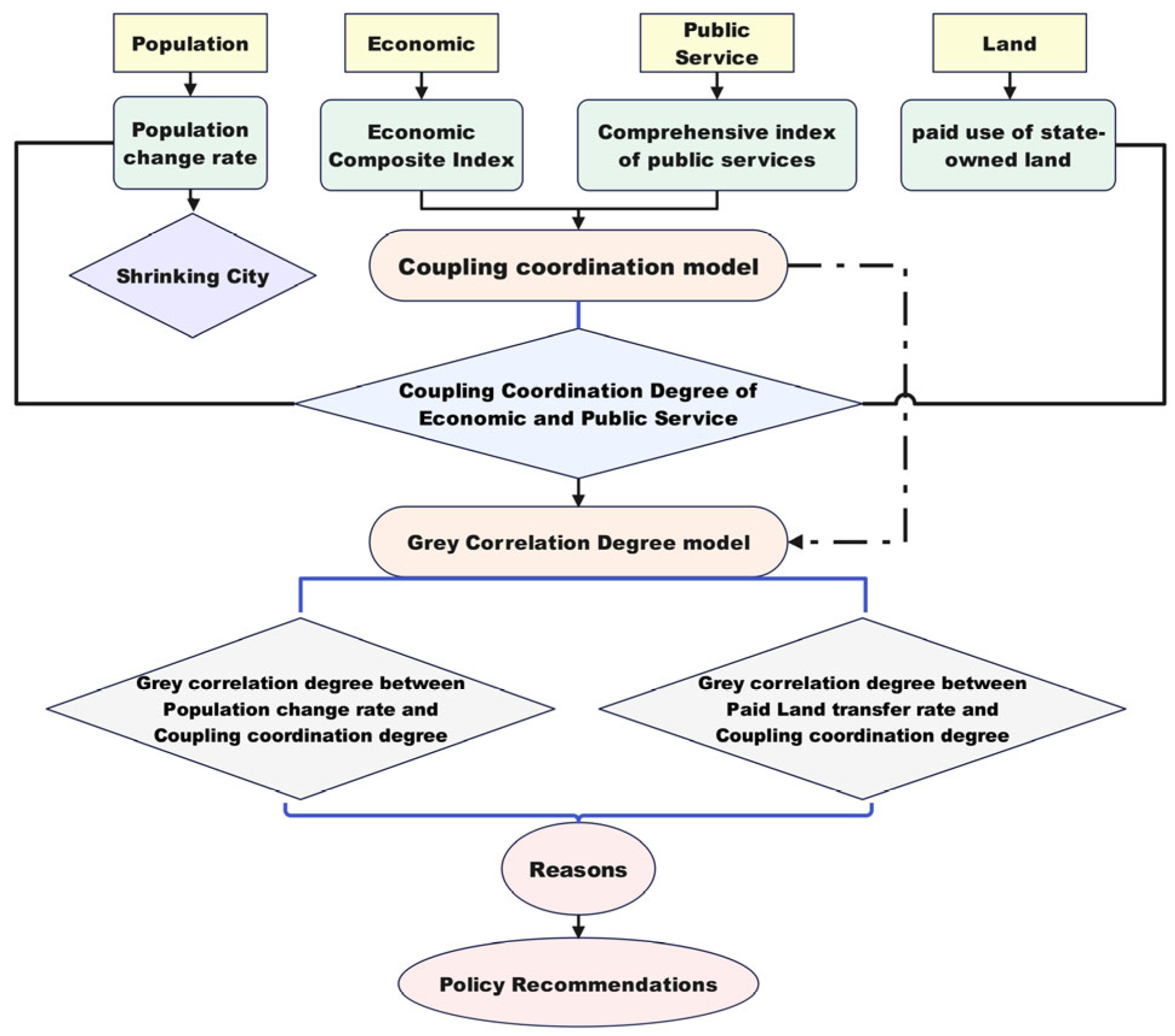
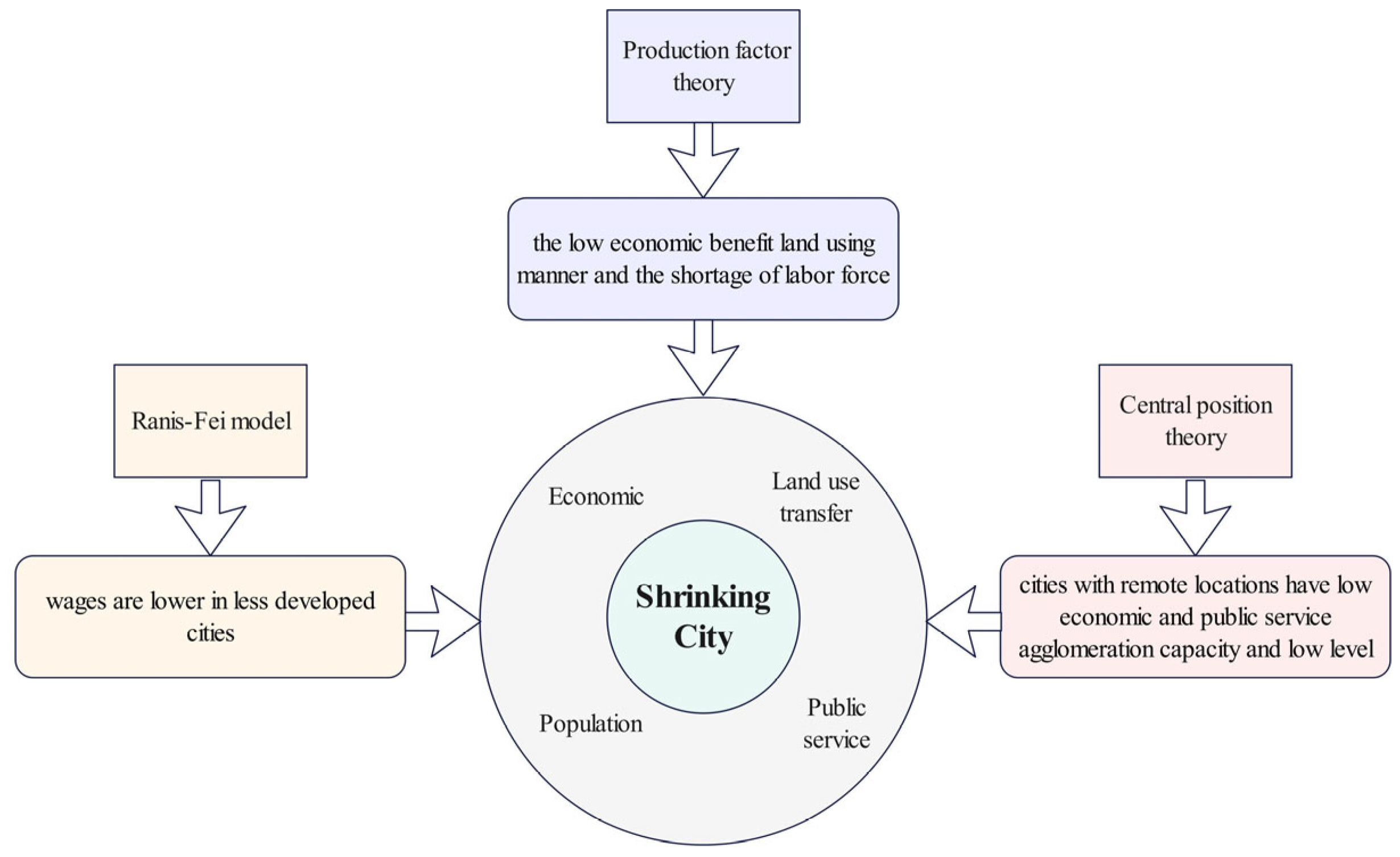
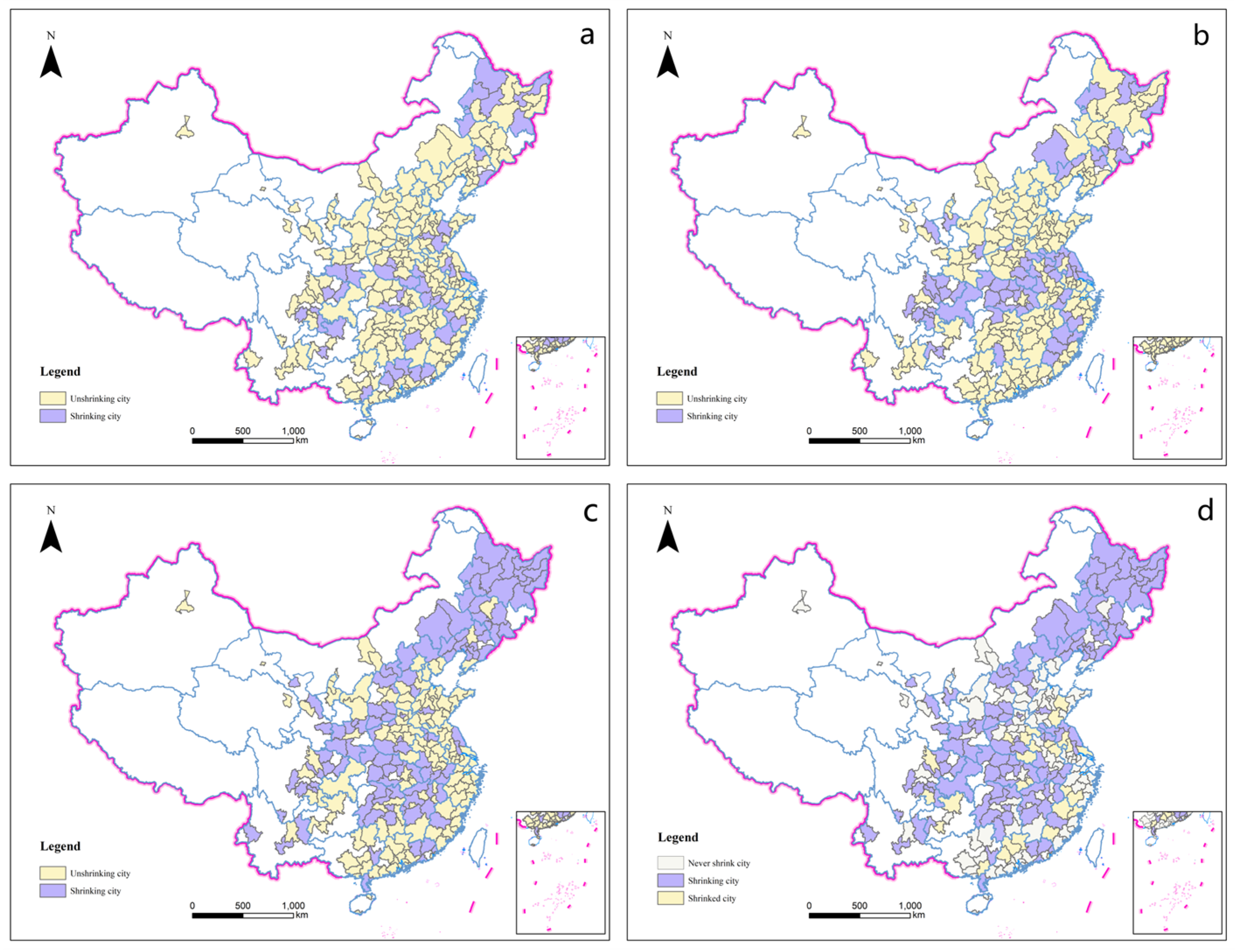

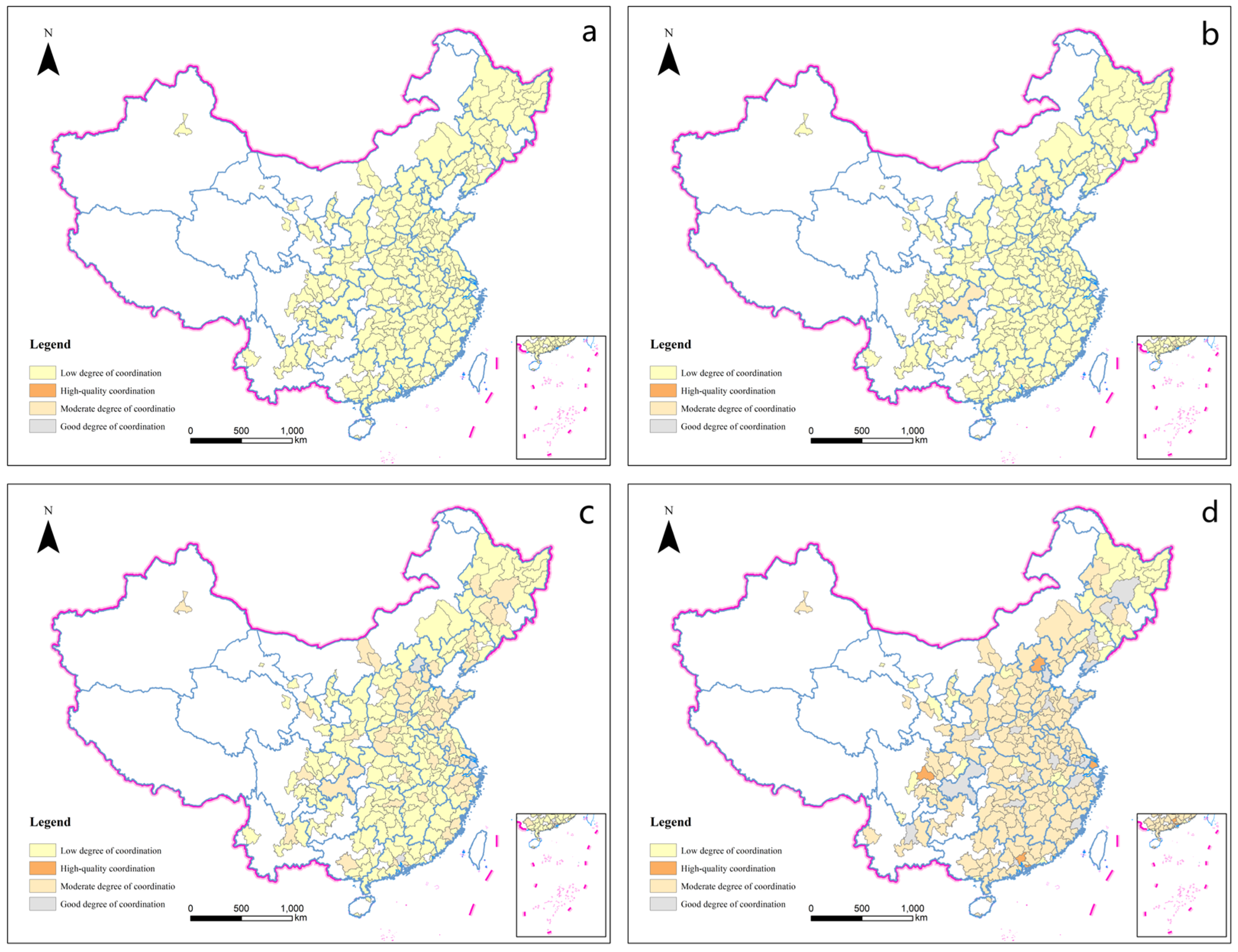

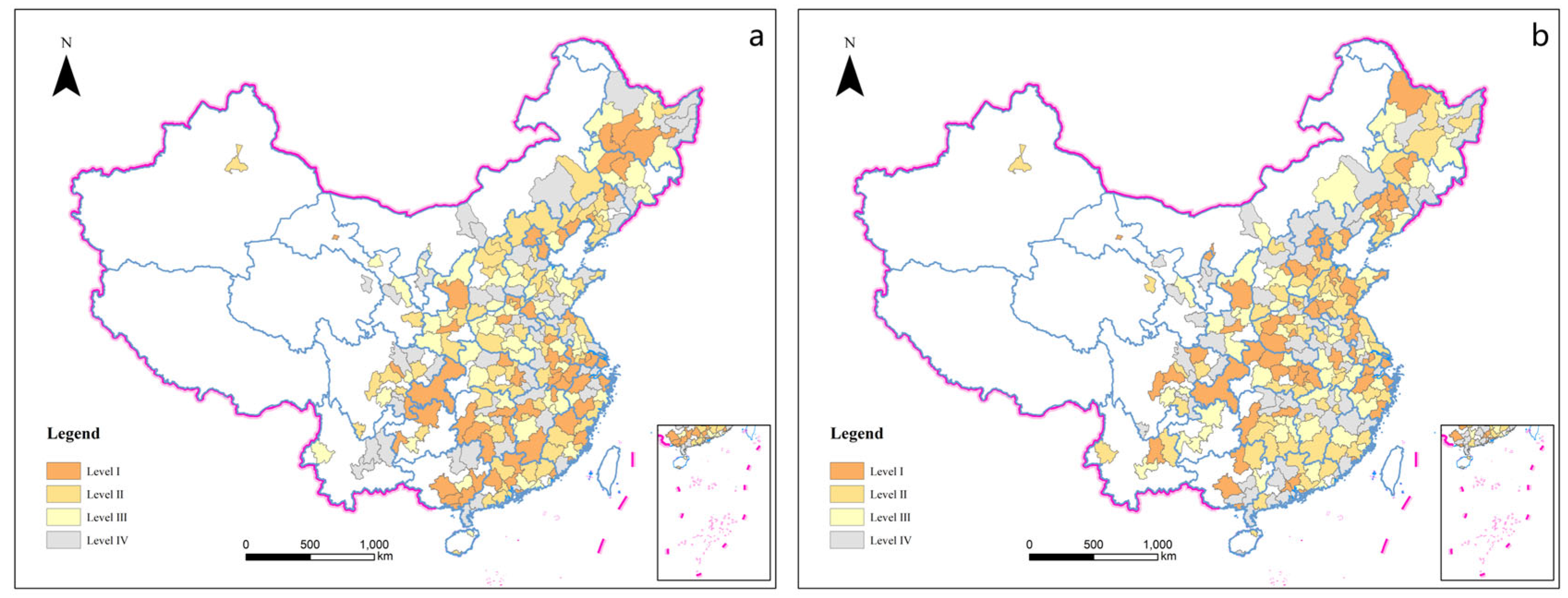

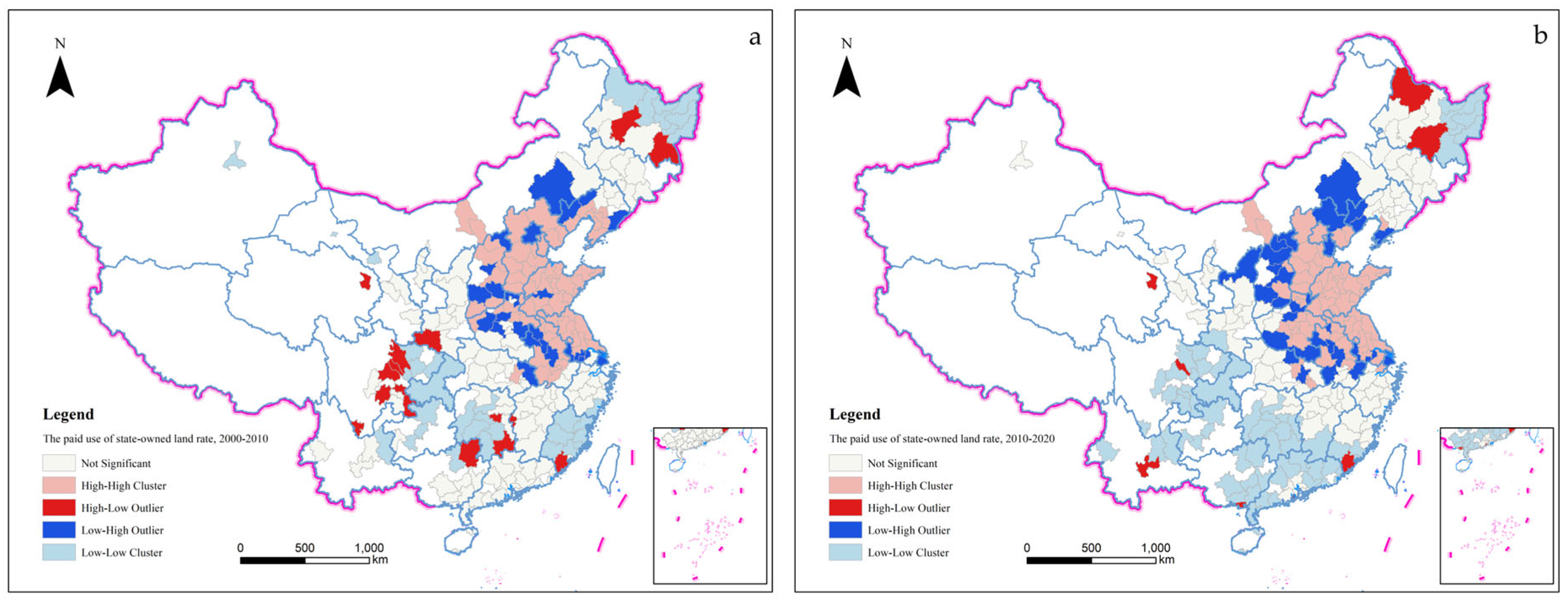

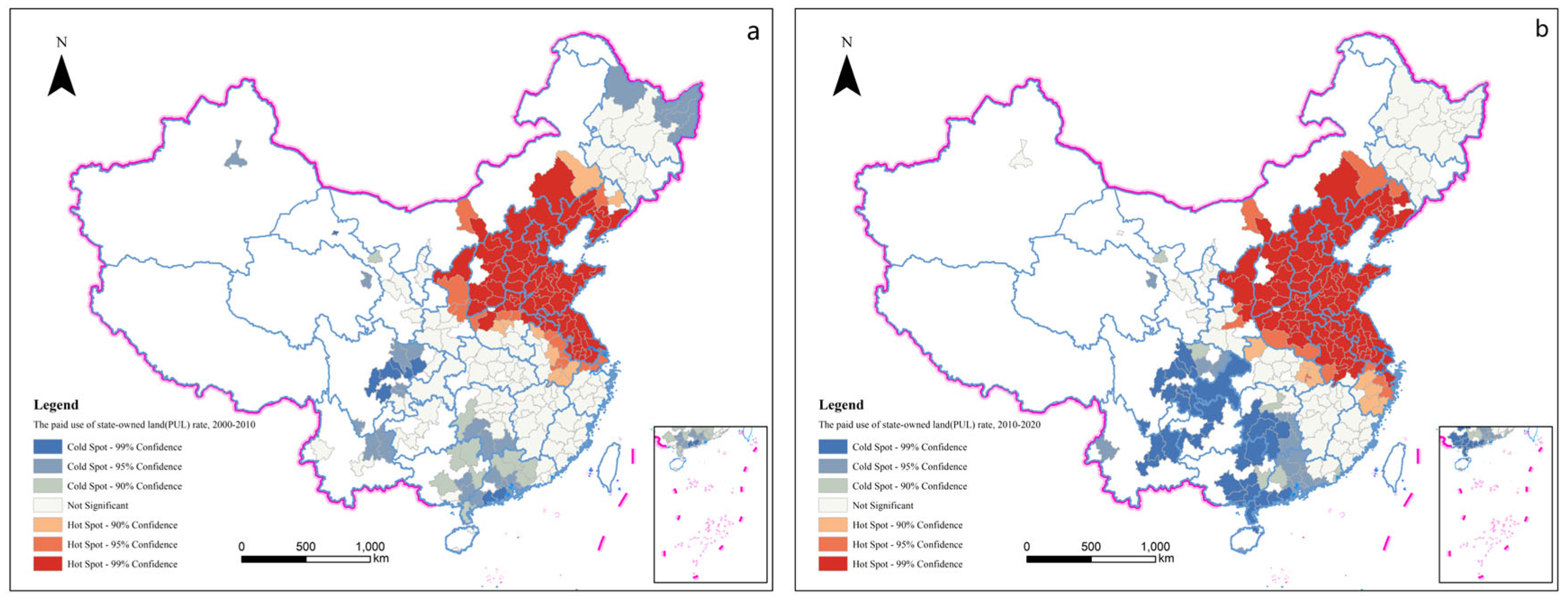
| Indicator Layer | Indicator Breakdown Layer | Unit | Indicator Calculation or Source | Indicators Sources |
|---|---|---|---|---|
| Population | population change rate | % | the rate of population growth due to natural and migration changes in a given period of time | Wang et al., 2022 [15] |
| Land | PUL rate | % | PUL area/total state-owned land use area × 100% | Zhang et al., 2015 [41] |
| Economic | per capita GDP | CNY | the per capita quantity of the value of the final results of production activities in all permanent units of the state during the year | Guan et al., 2021 [12] |
| average salary of employees | CNY | the average amount of money directly paid by the unit to all the on-duty employees of the unit in the report | Zhang et al., 2015 [41] | |
| Public services | local general public budget expenditure | CNY | local general public budgets, including expenditures on general public services, public security, and expenditures on various social undertakings coordinated by local governments | Guan et al., 2021 [12] |
| the number of hospital beds | / | the fixed actual beds (nonestablished beds) in hospitals at all levels and types | Sun et al., 2024 [46] | |
| the number of public primary and secondary schools | / | regular junior and senior secondary schools and the number of independently established schools that enroll school-age children in primary education | Ding et al., 2022 [47] | |
| number of buses and trolley buses under operation at year end | / | refers to the total number of vehicles under operation by public transport enterprises (units) at the end of the year | Sun et al., 2024 [46] | |
| the number of library books | / | the total number of ancient book issues and newspaper subscriptions, pamphlets and manuscripts, microforms, videotapes, audio tapes, CD-ROMs, listening and visual documents cataloged in the public library | Sun et al., 2024 [46] |
| System | Index | Property | Weight |
|---|---|---|---|
| Economic | per capita GDP | + | 0.512 |
| Average salary of employees | + | 0.488 | |
| Public services | local general public budget expenditure | + | 0.244 |
| the number of hospital beds | + | 0.156 | |
| the number of public primary and secondary schools | + | 0.137 | |
| number of buses and trolley buses under operation at year end | + | 0.260 | |
| the number of library books | + | 0.203 |
| State | |
|---|---|
| = 0 | independent state |
| 0 <≤ 0.3 | low-level coupling state |
| 0.3 < ≤ 0.5 | antagonistic coupling state |
| 0.5 < ≤ 0.8 | running-in coupling state |
| 0.8 < < 1 | high-level coupling state |
| = 1 | complete coupling |
| Range | State |
|---|---|
| 0 < D ≤ 0.3 | low degree of coordination |
| 0.3 < D ≤ 0.5 | moderate degree of coordination |
| 0.5 < D ≤ 0.7 | good degree of coordination |
| 0.7 < D ≤ 1 | high degree of coordination |
| Data | Moran’s I | Z | P | |
|---|---|---|---|---|
| Population change rate | 1990–2000 | −0.005 | −0.189 | 0.850 |
| 2000–2010 | 0.019 | 2.773 | 0.006 | |
| 2010–2020 | 0.125 | 14.2403 | 0.000 | |
| PUL rate | 2000–2010 | 0.095 | 10.813 | 0.000 |
| 2010–2020 | 0.097 | 11.690 | 0.000 | |
Disclaimer/Publisher’s Note: The statements, opinions and data contained in all publications are solely those of the individual author(s) and contributor(s) and not of MDPI and/or the editor(s). MDPI and/or the editor(s) disclaim responsibility for any injury to people or property resulting from any ideas, methods, instructions or products referred to in the content. |
© 2024 by the authors. Licensee MDPI, Basel, Switzerland. This article is an open access article distributed under the terms and conditions of the Creative Commons Attribution (CC BY) license (https://creativecommons.org/licenses/by/4.0/).
Share and Cite
Shan, X.; Li, Z.; Shao, X.; Wang, X.; Feng, Z.; Wu, K. How Do Population Changes and Land Use Policies Affect the Relationship between the Urban Economy and Public Services? Land 2024, 13, 524. https://doi.org/10.3390/land13040524
Shan X, Li Z, Shao X, Wang X, Feng Z, Wu K. How Do Population Changes and Land Use Policies Affect the Relationship between the Urban Economy and Public Services? Land. 2024; 13(4):524. https://doi.org/10.3390/land13040524
Chicago/Turabian StyleShan, Xinyu, Zihan Li, Xinyi Shao, Xinyi Wang, Zhe Feng, and Kening Wu. 2024. "How Do Population Changes and Land Use Policies Affect the Relationship between the Urban Economy and Public Services?" Land 13, no. 4: 524. https://doi.org/10.3390/land13040524







